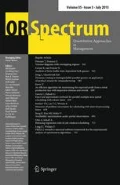Abstract
We study the impact of supply chain visibility on periodic review inventory control, by studying its effect on lead time, where lead time is assumed to be random. We break down the total lead time from a supplier to a retailer into individual smaller lead times, as the product is tracked moving from one intermediary location to another. (This can be achieved, for example, through the use of RFID technology.) Under optimality, we observe that the average expected cost per cycle that the retailer can achieve in the long run given supply chain visibility is no worse than that for the base periodic review model without such visibility. An example is given which shows that there is indeed cost savings in the former, as compared with the base model. Further numerical results are then given to quantify the benefits of supply chain visibility on retailer’s cost with defined simple lead-time distributions. We also report on any trends that might appear as input parameters are varied in the numerical experiments.
Similar content being viewed by others
References
Anderson EJ (1989) A Note on the dynamic lot-size model with uncertainty in demand and supply processes. Manag Sci 35: 635–640
Bashyam S, Fu MC (1998) Optimization of (s,S) inventory systems with random lead times and a service level constraint. Manag Sci 44: S243–S255
Bradley JR, Robinson LW (2005) Improved base-stock approximations for independent stochastic lead times with order crossover. Manuf Serv Oper Manag 7: 319–329
Cachon GP, Fisher M (2000) Supply chain inventory management and the value of shared information. Manag Sci 46: 1032–1048
Ehrhardt R (1984) (s,S) policies for a dynamic inventory model with stochastic lead times. Oper Res 32: 121–132
Gaukler GM (2006) RFID in supply chain management. ProQuest/UMI
Gaukler GM, Özer Ö, Hausman WH (2008) Order progress information: improved dynamic emergency ordering policies. Prod Oper Manag 17: 599–613
Hadley G, Whitin TM (1963) Analysis of inventory systems. Prentice-Hall International Series in Management,
He XX, Xu SH, Ord JK, Hayya JC (1998) An inventory model with order crossover. Oper Res 46: S112–S119
Heuts R, de Klein J (1995) An (s,q) inventory model with stochastic and interrelated lead times. Naval Res Logist 42: 839–859
Janakiraman G, Roundy RO (2004) Lost-sales problems with stochastic lead times convexity results for base-stock policies. Oper Res 52: 795–803
Kambil A, Brooks JD (2002) Auto-ID across the value chain: from dramatic potential to greater efficiency & profit. Auto-ID Center white paper
Kaplan RS (1970) A dynamic inventory model with stochastic lead times. Manag Sci 16: 491–507
Kim JG, Sun D, He XJ, Hayya JC (2004) The (s,Q) inventory model with erlang lead time and deterministic demand. Naval Res Logist 51: 906–923
Lee HL, Özer Ö (2007) Unlocking the value of RFID. Prod Oper Manag 16: 40–64
Liberatore MJ (1979) The EOQ model under stochastic lead time. Oper Res 27: 391–396
Luedtke JR, White III CC (2004) The value of asset visibility in the supply chain: single and dual source models. 2004 IEEE International Conference on Systems, Man and Cybernetics. 4189–4194
Nahmias S (1979) Simple approximations for a variety of dynamic leadtime lost-sales inventory models. Oper Res 27: 904–924
Nevison C, Burstein M (1984) The dynamic lot-size model with stochastic lead times. Manag Sci 30: 100–109
Song J-S (1994) The effect of leadtime uncertainty in a simple stochastic inventory model. Manag Sci 40: 603–613
Song J-S, Zipkin P (1996) Inventory model with information about supply conditions. Manag Sci 42: 1409–1419
Sphicas GP (1982) On the solution of an inventory model with variable lead times. Oper Res 30: 404–410
Sphicas GP, Nasri F (1984) An inventory model with finite-range stochastic lead times. Naval Res Logist Q 31: 609–616
Topkis DM (1968) Optimal Ordering and rationing policies in a nonstationary dynamic inventory model with n demand classes. Manag Sci 15: 160–176
Zipkin P (1986) Stochastic leadtimes in continuous-time inventory models. Naval Res Logist Q 33: 763–774
Author information
Authors and Affiliations
Corresponding author
Rights and permissions
About this article
Cite this article
Chew, E.P., Lee, L.H. & Sim, CK. The impact of supply chain visibility when lead time is random. OR Spectrum 35, 163–190 (2013). https://doi.org/10.1007/s00291-011-0254-3
Published:
Issue Date:
DOI: https://doi.org/10.1007/s00291-011-0254-3




